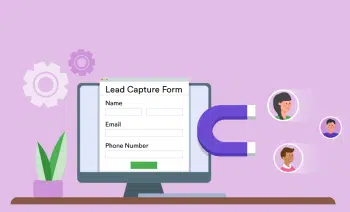Do you rely on your website to generate leads for your sales team? If so, lead capture form best practices are critical to ensure you’re converting all the traffic that you can. Most website visitors bounce, but we’ll share some simple guidelines to help you convert as many of them as possible into leads for your sales reps.
We’ll even share a secret weapon you can use to increase your conversion rate to as high as 40 percent!
Positioning
There are two factors to consider when it comes to where to place a lead capture form. First, you don’t want to hurt the user experience. Second, you want to make sure the form gets visitors’ attention.
For example, when implemented poorly, popup forms annoy users. But they get their attention.
On the other hand, placing an inline form after the first paragraph of a blog post and another one at the end of the post gets attention without being a nuisance. Some readers will stop reading to fill out the form, especially if the offer is an eBook version of the post.
Others will keep reading, but they’ll have another opportunity to convert if they finish the post.
Length
Avoid making your lead capture forms too long. They should be as short as possible while still allowing you to take the necessary next steps. For example, you’ll need their mailing address if they’re filling out a form to get a free sample.
(Fortunately, the secret weapon we mentioned earlier will allow you to collect more information without requiring your visitors to fill out a lengthy form.)
Field Selection
Like the length, you should determine the fields to include primarily based on what information you need to fulfill your end of the bargain. At a minimum, your lead capture forms should request an email address, and ideally, you’ll get a first name too so you can personalize your emails to the lead.
Generally, the deeper in the sales funnel the visitor is, the more willing they will be to give out more personal information (e.g., a phone number).
(But even at the bottom of the funnel, consumers are wary about handing over too much of their personal information. So, again, keep reading to find out about a tool to help you handle this.)
Button Copy
The first rule of submit buttons for lead capture forms is that they should never say “Submit.” Instead, emphasize the value your visitor will get by submitting the form. For example, you might say, “Send Me My Free Sample” or “Give Me Free Shipping!”
Visitor Identification
No matter what you do, most of your traffic will bounce without completing and submitting a lead capture form. In the past, that meant you had no way to contact them other than retargeting ads.
But not anymore.
Now, visitor identification is your secret weapon. It uses the latest tracking technology and third-party data to convert your anonymous web traffic into leads–without requiring a form submission!
Optimize Your Lead Capture Forms and Have a Backup Plan
It’s essential to improve your lead capture forms until they’re converting as well as possible. But don’t rely on them entirely. Use visitor identification to capture the leads that fall through the cracks.
Want to see how it works? You can get 100 free leads to try it out when you sign up for LeadPost today.
